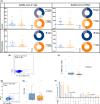Virological and immunological features of SARS-COV-2 infected children with distinct symptomatology
- PMID: 34174102
- PMCID: PMC8420243
- DOI: 10.1111/pai.13585
Virological and immunological features of SARS-COV-2 infected children with distinct symptomatology
Abstract
Background: Although SARS-CoV-2 immunizations have started in most countries, children are not currently included in the vaccination programs; thus, it remains crucial to define their anti-SARS-CoV-2 immune response in order to minimize the risk for other epidemic waves. This study sought to provide a description of the virology ad anti-SARS-CoV-2 immunity in children with distinct symptomatology.
Methods: Between March and July 2020, we recruited 15 SARS-CoV-2 asymptomatic (AS) and 51 symptomatic (SY) children, stratified according to WHO clinical classification. We measured SARS-CoV-2 viral load using ddPCR and qPCR in longitudinally collected nasopharyngeal swab samples. To define anti-SARS-CoV-2 antibodies, we measured neutralization activity and total IgG load (DiaSorin). We also evaluated antigen-specific B and CD8+T cells, using a labeled S1+S2 protein and ICAM expression, respectively. Plasma protein profiling was performed with Olink.
Results: Virological profiling showed that AS patients had lower viral load at diagnosis (p = .004) and faster virus clearance (p = .0002) compared with SY patients. Anti-SARS-CoV-2 humoral and cellular response did not appear to be associated with the presence of symptoms. AS and SY patients showed similar titers of SARS-CoV-2 IgG, levels of neutralizing activity, and frequency of Ag-specific B and CD8+ T cells, whereas pro-inflammatory plasma protein profile was found to be associated with symptomatology.
Conclusion: We demonstrated the development of anti-SARS-CoV-2 humoral and cellular response with any regard to symptomatology, suggesting the ability of both SY and AS patients to contribute toward herd immunity. The virological profiling of AS patients suggested that they have lower virus load associated with faster virus clearance.
Keywords: Ag-specific cellular response; SARS-CoV-2; asymptomatic patients; neutralization humoral activity; symptomatic patients.
© 2021 EAACI and John Wiley and Sons A/S. Published by John Wiley and Sons Ltd.
Conflict of interest statement
The authors have no conflict of interest to declare.
Figures



References
-
- Panovska‐Griffiths J, Kerr CC, Stuart RM, et al. Determining the optimal strategy for reopening schools, the impact of test and trace interventions, and the risk of occurrence of a second COVID‐19 epidemic wave in the UK: a modelling study. Lancet Child Adolesc Health. 2020;4:817‐827. 10.1016/S2352-4642(20)30250-9 - DOI - PMC - PubMed
-
- Head JR, Andrejko K, Cheng Q, et al. The effect of school closures and reopening strategies on COVID‐19 infection dynamics in the San Francisco Bay Area: a cross‐sectional survey and modeling analysis. medRxiv. 2020. 10.1101/2020.08.06.20169797. Preprint. - DOI
Publication types
MeSH terms
Substances
Grants and funding
LinkOut - more resources
Full Text Sources
Medical
Research Materials
Miscellaneous

